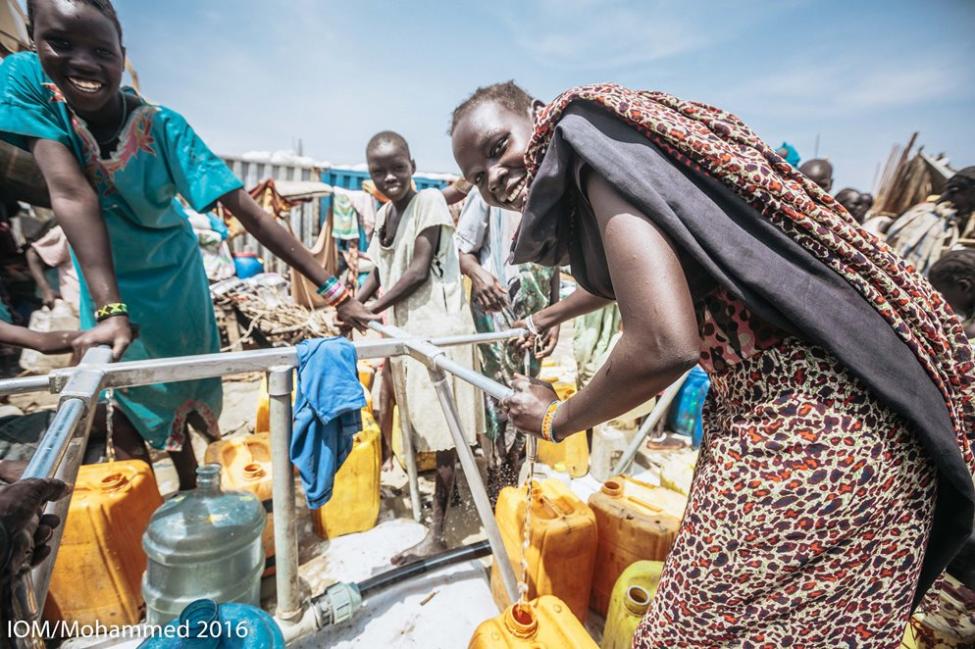-
Who We Are
WHO WE AREThe International Organization for Migration (IOM) is part of the United Nations System as the leading inter-governmental organization promoting since 1951 humane and orderly migration for the benefit of all, with 175 member states and a presence in over 100 countries. IOM has had a presence in South Sudan since 2011.
About
About
IOM Global
IOM Global
-
Our Work
Our WorkAs the leading inter-governmental organization promoting humane and orderly migration, IOM plays a key role to support the achievement of the 2030 Agenda through different areas of intervention that connect both humanitarian assistance and sustainable development. IOM South Sudan provides a comprehensive response to the humanitarian needs of migrants, internally displaced persons, returnees and host communities.
Cross-cutting (Global)
Cross-cutting (Global)
- Data and Resources
- Take Action
- 2030 Agenda
IOM Responds to Needs at Malakal PoC Site, South Sudan, after Destruction
 South Sudan, 11 March 2016 – Three weeks after fighting destroyed and damaged 35 per cent of the UN protection of civilians (PoC) site in Malakal, South Sudan, thousands of people continue to live in dire conditions. IOM and humanitarians are working tirelessly to beat the clock and ensure that more than 40,000 internally displaced persons (IDPs) have sufficient shelter before heavy seasonal rains begin in two months’ time.
South Sudan, 11 March 2016 – Three weeks after fighting destroyed and damaged 35 per cent of the UN protection of civilians (PoC) site in Malakal, South Sudan, thousands of people continue to live in dire conditions. IOM and humanitarians are working tirelessly to beat the clock and ensure that more than 40,000 internally displaced persons (IDPs) have sufficient shelter before heavy seasonal rains begin in two months’ time.
Fighting, which erupted on 17 February 2016, forced most IDPs to flee their shelters to areas of the UN Mission in South Sudan base perceived to be safer but not suitable for accommodating thousands of IDPs. At least 25 people died during the attack and more than 120 were injured.
Over 30,000 people are now living in makeshift shelters. The area is extremely crowded, with an average of only 2.5 square metres of living space per person. Congestion is leading to poor sanitation and increasing the risk for the spread of disease.
After a devastating rainy season in 2014, IOM led a massive expansion of the site to improve living conditions and IDP access to relief services. Now that IDPs have fled these areas, humanitarians fear a repeat of 2014, when thousands lived in knee-high water and waterborne diseases were rampant.
“Before the rains begin, damaged areas must be repaired in order for IDPs to return and relief services to resume. At the same time, efforts should start immediately to develop additional areas to provide acceptable living conditions and reduce overcrowding. Even before the February attack, at least 36,000 IDPs already lived in severely congested areas due to space constraints,” explained Anders Haugland, IOM Malakal Head of Sub-Office.
Lifesaving operations continue as efforts to improve the damaged areas begin. IOM has taken swift action to provide safe drinking water to more than 40,000 IDPs. On the second day of fighting, one staff risked his life to walk 2 kilometres, after dark and without protection, to IOM’s water-pump system at the White Nile River to ensure that water continued to flow to the PoC site. IOM is also constructing latrines and conducting hygiene promotion to minimise the impact of crowded conditions on the health of children and their families
IOM’s primary health care clinic, including a new maternity ward, was burned to the ground during the attack. However, IOM adapted quickly and opened a temporary clinic, offering full primary health care services and maternal care. Last week, medical staff saw nearly 2,300 patients and delivered nine babies.
Most IDPs fled the fighting with little-to-no belongings, many with literally only the clothing on their backs. One such IDP, Nyarok, a young mother of four, is living with her relatives and children in two tents cobbled together with IOM plastic tarp, poles and sheets.
Despite immense needs, when asked what she wanted most, Nyarok said “we only want our people to live in peace.”
